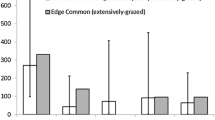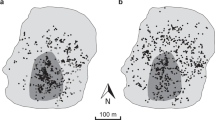Abstract
The effects of large-scale cattle grazing by herdsmen (Allmende) on the populations of two butterfly species, Coenonympha glycerion and Lasiommata megera, were analysed on a study plot in the foothills of the Eastern Carpathians, Republic of Ukraine, in the summer and autumn of 1995. In all, 280 individuals of C. glycerion (115 females) and 230 individuals of L. megera (61 females) were individually marked. At recapture rates of 35 to 39%, maximum population size was calculated at 410 and 434 individuals. C. glycerion reacted to high densities by shifting to smaller neighbouring habitats. An increased emigration rate was recorded for L. megera when the population maximum was reached.Both species essentially require habitats formed by the activity of cattle. C. glycerion significantly preferred south facing woodland margins, close to moderately and infrequently grazed grassland. Heavily grazed areas were avoided. L. megera mainly occupied well-trod cattle paths or landslips with rather sparse vegetation, induced by cattle. Preferred habitats are characterized by linear structures for patrolling, steep slope areas and a wide range of nectar resources. Smaller, sporadically used cattle paths did not show these features and were occupied mainly by males at times of high population densities. Both species depend on patchy habitat mosaics which will be lost by intensification as well as by a complete cessation of grazing. The low-intensity, large-scale system utilized in the Eastern Carpathians is therefore favourable to both species.
Similar content being viewed by others
References
Baughman, J.F., Murphy, D.D. and Ehrlich, P.R. (1988) Population structure of a hilltopping butterfly. Oecologia 75, 593–600.
Begon, M. (1979) Investigating animal abundance: Capture-recapture for biologists. London: E. Arnold.
Beinlich, B. (1996) Die mitteleuropäische Kulturlandschaft als jeweiliges Abbild der Nutzungsansprüche des Menschen an seine Umwelt. In Wo lebten Pflanzen und Tiere in der Naturlandschaft und der frühen Kulturlandschaft Europas?–Natur-und Kulturlandschaft 1 (B. Gerken and C. Meyer, eds) pp. 1204. Höxter.
Beinlich, B. and Plachter, H. (1995a) Nutzungorientierte Schutz-und Entwicklungsstrategien für die Kalkmagerrasen (Mesobromion) der Schwäbischen Alb. Landschaftspfl. Quo vadis II, 25–55.
Beinlich, B. and Plachter, H. (eds) (1995b) Schutz und Entwicklung der Kalkmagerrasen der Schwäbischen Alb. Beih. Veröff. Naturschutz Landschaftspflege Bad.-Württ. 83, 1–520.
Bignal, E.M. and McCracken, D.I. (1996) Low-intensity farming systems in the conservation of the countryside. J. Appl. Ecol. 33, 413–24.
Bruckhaus, A. (1988) Biotopschutz durch extensive Beweidung am Beispiel der Enzian-Schillergrasrasen. Schr.R. Bayer. Landesamt f.Umweltschutz 84, 125–33.
Brunzel, S. (1996) Populationsoökologische Untersuchungen am Schwalbenschwanz (Papilio machaonL. 1758). Z. Ökologie u. Naturschutz 5, 37–46.
Davies, N.B. (1978) Territorial defence in the speckled wood butterfly (Pararge aegeria): The resident always wins. Anim. Behav. 26, 138–47.
Dennis, R.L.H. (1982) Mate location strategies in the Wall Brown butterfly Lasiommata megera(L.) (Lepidoptera: Satyridae): wait or seek? Entomologist’s Rec. J. Var. 94, 209–14; 95, 7–10.
Dennis, R.L.H. (1983) Egg-laying cues in the wall brown butterfly, Lasiommata megera(L.) (Lepidoptera, Satyridae). Entomologist’s Gaz. 34, 89–95.
Dennis, R.L.H. (1987) Hilltopping as a mate location strategy in a mediterranean population of Lasiommata megera(L.) (Lepidoptera, Satyridae). Nota Lepid. 10, 65–70.
Dennis, R.L.H. and Bramley, M.J. (1985) The influence of man and climate on dispersion patterns within a population of adult Lasiommata megera(L.) (Lepidoptera, Satyridae) at Brereton Heath, Cheshire (UK). Nota Lepid. 8, 309–24.
Ebert, G. and Rennwald, E. (1991) Die Schmetterlinge Baden-Württembergs, Band 2. Stuttgart: Verlag Eugen Ulmer.
Hanski, I., Kuussaari, M. and Nieminen, M. (1994) Metapopulation structure and migration in the butterfly Melitaea cinxia. Ecology 73 (3), 747–62.
Hempel, W. (1971) Zum Einfluß der Weidewirtschaft auf die Arthropodenfauna der Mittelgebirge. Faun. Abh. Staatl. Mus. Tierkunde Dresden 3, 235–81.
Kierchner, G.J. (1993) Faunistische Untersuchungen auf extensiv und konventionell bewirtschafteten Grünlandstandorten des Unteren Niederrheins. LöLF Jahresberichte, 55–7.
Klein, M., Riecken, U. and Schröder, E. (1997) Alternative Konzepte des Naturschutzes für extensiv genutzte Kulturlandschaften. Schriftenreihe Landschaftspflege und Naturschutz(in press).
Lederhouse, R.C. (1982) Territorial defense and lek behavior of the Black Swallowtailed Butterfly, Papilio polyxenes. Behav. Ecol. Sociobiol. 10, 109–18.
Loertscher, M., Erhardt, A. and Zettel, J. (1995) Microdistribution of butterflies in a mosaic-like habitat: the role of nectar sources. Ecography 18, 15–26.
Luick, R. (1996) Extensive Rinderweiden. Gemeinsame Chancen für Natur, Landschaft und Landwirtschaft. Naturschutz und Landschaftsplanung 28(2), 37–45.
Muggleton, J. and Benham, B.R. (1975) Isolation and decline of the Large Blue Butterfly (Maculinea arion) in Great Britain. Biol. Conserv. 7, 119–28.
Plachter, H. (1996a) A Central European approach for the protection of biodiversity. In Nature conservation outside protected areas(D. Ogrin, ed.) pp. 91–108. Conf. Proc. Ministry of Environment and Physical planning, Ljubljana.
Plachter, H. (1996b) Ecological aspects of Central European cultural landscapes. In Asian rice culture and its terraced landscapes(A. Villalon, ed.) Manila (in press).
Ravenscroft, N.O.M. (1994) The ecology of the chequered skipper butterfly Carterocephalus palaemonin Scotland. I. Microhabitat. J. Appl. Ecol. 31, 613–22.
Rutowski, R.L. (1991) The evolution of male-locating behavior in butterflies. Amer. Naturalist 138, 1121–39.
Schweizerischer Bund für Naturschutz, ed. (1988) Tagfalter und ihre Lebensräume. Arten-Gefährdung-Schutz. Basel: SBN.
Shapiro, A.M. (1970) The role of sexual behaviour in densityrelated dispersal of pierid butterflies. Amer. Naturalist 104, 367–72.
Sharp, M.A., Parks, D.R. and Ehrlich, P.R. (1974) Plant resources and butterfly habitat selection. Ecology 55, 870–5.
Thomas, C.D. and Harrison, S. (1992) Spatial dynamics of a patchily distributed butterfly species. J. Animal Ecol. 61, 437–46.
Thomas, C.D., Thomas, J.A. and Warren, M.S. (1992) Distribution of occupied and vacant butterfly habitats in fragmented landscapes. Oecologia 92, 563–7.
Warren, M.S. (1987a) The ecology and conservation of the Heath Fritillary Butterfly, Mellicta athaliaII. J. Appl. Ecol. 24, 483–98.
Warren, M.S. (1987b) The ecology and conservation of the Heath Fritillary Butterfly, Mellicta athaliaIII. J. Appl. Ecol. 24, 499–513.
Weidemann, H.J. (1995) Tagfalter: beobachten, bestimmen. Augsburg: Naturbuch Verlag.
Wickman, P.-O. (1985) The influence of temperature on the territorial and mate locating behaviour of the small heath butterfly, Coenonympha pamphilus(L.) (Lepidoptera, Satyridae). Behav. Ecol. Sociobiol. 16, 233–8.
Wickman, P.-O. (1986) Courtship solicitation by females of the small heath butterfly, Coenonympha pamphilus(L.) (Lepidoptera, Satyridae) and their behaviour in relation to male territories before and after copulation. Anim. Behav. 34, 153–7.
Wickman, P.O. and Wiklund, C. (1983) Territorial defence and its seasonal decline in the Speckled Wood Butterfly (Pararge aegeria). Anim. Behav. 31, 1206–16.
Rights and permissions
About this article
Cite this article
Elligsen , H., Beinlich , B. & Plachter, H. Effects of large-scale cattle grazing on populations of Coenonympha glycerion and Lasiommata megera (Lepidoptera:Satyridae). Journal of Insect Conservation 1, 13–23 (1997). https://doi.org/10.1023/A:1018470723539
Issue Date:
DOI: https://doi.org/10.1023/A:1018470723539




